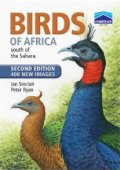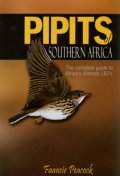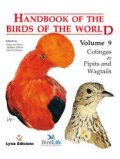On this page
Books about LongclawsThis page lists books that are wholly or partly about Longclaws. The books are listed by publication date with the most recent at the top.
Longclaws
Family: Motacillidae
Genus: Macronyx
Longclaws are African passerines that are generally found in savanna and other grassland environments. There are 8 species:
Abyssinian Longclaw
Macronyx flavicollis
Cape Longclaw
Macronyx capensis
Fülleborn's Longclaw
Macronyx fuellebornii
Grimwood's Longclaw
Macronyx grimwoodi
Pangani Longclaw
Macronyx aurantiigula
Rosy-throated Longclaw
Macronyx ameliae
Sharpe's Longclaw
Macronyx sharpei
Yellow-throated Longclaw
Macronyx croceus
|
|
|
|
Birds of Africa: South of the SaharaIan Sinclair and Peter Evans
Struik Nature
2nd edition
2010
"With over 2,500 photographs, the text, by Africa's top birders, this indispensable companion in the field gives identification, call, habitat, status, breeding and diet, with calendar bars showing breeding, and distribution maps. Fully revised, Birds of Africa south of the Sahara provides unrivalled coverage of African birds in a single volume, and is the first book to describe and illustrate all of the birds found in Africa south of the Sahara Desert (the Afrotropic Region), including Socotra, Pemba and islands in the Gulf of Guinea. Despite its exceptional coverage of over 2,100 species described, plus 70 vagrants, this guide is compact enough to use in the field, and follows the standard field guide format, with texts and range maps appearing opposite the color plates. Comprehensively revised to reflect changes in taxonomy. Illustrations show most distinctive plumages, diagnostic flight patterns and major geographic variants."
|
Buy from amazon.co.uk 
|
|
Pipits of Southern Africa: The Complete Guide to Africa's Ultimate LBJ'sFaansie Peacock
Mirafra
2006
Includes some information on Longclaws but not as detailed as the coverage of Pipits.
"Ask any birder and they will confirm that pipits are arguably the most challenging birds in Africa from an identification perspective. In addition, pipit taxonomy is by no means conclusive-two new species have been described in the last decade! Despite this challenging state of affairs, identification of this group is possible. In Pipits of Southern Africa, emphasis is shifted towards identification methods based largely on posture, feeding strategy, display flights, vocalizations and other non-plumage features. The book stems directly from the author's field notes (instead of from museum collections and ornithological papers alone) and it is immediately apparent that this is a book written by a birder for birders. However, despite the great care that has been taken to ensure that the book is readable and relevant, scientific technicalities are also covered in detail-Pipits of southern Africa should appeal to beginners, advanced birders and ornithologists alike. A vast amount of ink drawings are used to emphasize important points or illustrate complicated concepts, and a multitude of graphs, keys and diagrams to facilitate easy and correct identification are included. All southern African pipit species (including the recently described Kimberley and Long-tailed Pipits), are covered in detail."
|
Buy from amazon.co.uk 
|
|
Handbook of the Birds of the World, Vol. 9: Cotingas to Pipits and WagtailsEdited by Josep Del Hoyo, Andrew Elliott and David Christie
Illustrations: Norman Arlott, Hilary Burn, John Cox, Ren Hathway, Ian Lewington, Chris Rose, Brian Small, Ian Willis, Tim Worfolk
Lynx Edicions
2004
850 pages, 78 colour plates, colour photos, distribution maps.
This volume covers cotingas, manakins, tyrant-flycatchers, New Zealand wrens, scrub-birds, lyrebirds, larks, swallows, pipits and wagtails.
|
Buy from amazon.co.uk 
|
|